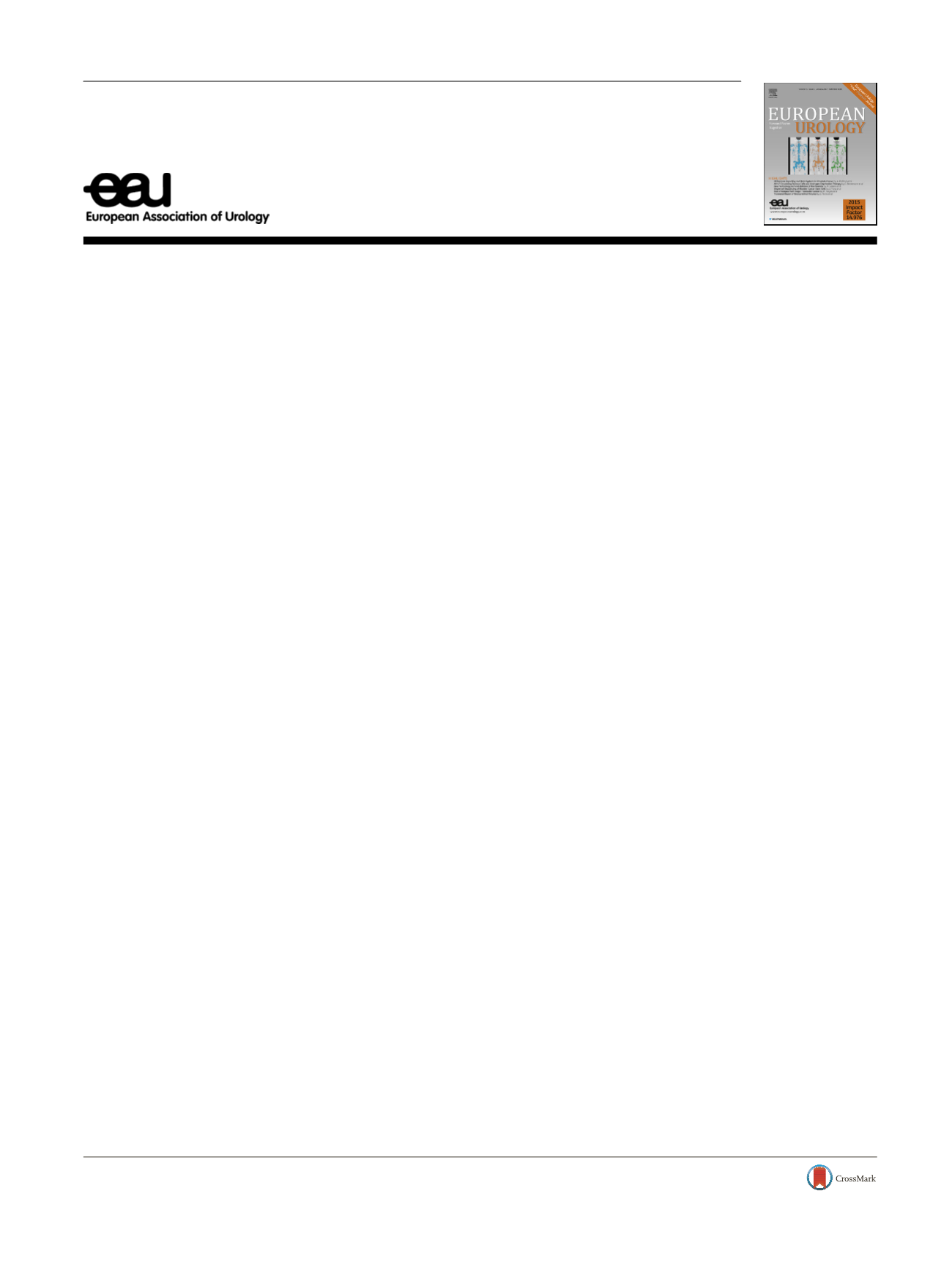

Platinum Priority – Editorial
Referring to the article published on pp. 738–744 of this issue
Optimal Radiotherapy for Unfavorable-risk Prostate Cancer
Juanita Crook
*University of British Columbia, BCCA Center for the Southern Interior, Kelowna, BC, Canada
In this month’s issue of
European Urology
, Johnson et al
[1]report improved overall survival (OS) for men with
unfavorable (intermediate- or high-risk) prostate cancer
treated with androgen suppression(AS) and external beam
radiotherapy (EBRT) combined with a low dose rate (LDR)
prostate brachytherapy boost compared with AS and EBRT
without brachytherapy. Their analysis used data from the
National Cancer Data Base for the period 2004–2012,
identifying 25 038 men, of whom 18% received an LDR
brachytherapy boost compared with 82% treated with dose-
escalated EBRT (dose range, 75.6–86.4 Gy). The use of an
LDR brachytherapy boost was associated with improved OS
in univariate analysis (7-yr OS: 82% vs 73%) and in
multivariate analysis the hazard ratio for death was 0.7
(95% confidence interval: 0.64–0.77).
Recognizing the limitations of large database analysis,
including nonrandomized design, selection bias, and lack of
data on cause of death, cancer-specific outcomes, and
duration of AS, the authors performed propensity score
matching using the covariates associated with treatment
selection on logistic regression. The advantage for the use of
an LDR brachytherapy boost persisted with a hazard ratio
for death of 0.74 (95% confidence interval: 0.66–0.89).
Acknowledging that there still may be unrecognized
cofounders, and that younger and healthier men are more
likely to be offered an invasive procedure as opposed to
EBRT alone, the authors went on to perform a subset
analysis limited to men under the age of 60 yr with no
comorbidities. The survival advantage for the use of an LDR
brachytherapy boost again persisted with a 7-yr OS of 90%
compared with 85% for dose-escalated EBRT (
p
<
0.001).
Is this plausible? Multiple mature randomized trials
show the benefits of dose escalation in the treatment of
prostate cancer with external beam radiation, with reduced
biochemical failure, metastatic failure, and prostate cancer-
specific mortality, although none has shown an improve-
ment in OS
[2–4]. The addition of brachytherapy provides
dose escalation far in excess of what can be achieved with
any external beam technique. Using an
a
:
b
ratio of
[2_TD$DIFF]
1.5 to 2,
the biologically equivalent dose with combined EBRT and
LDR brachytherapy is over 200 Gy
[5]. Stone et al
[5]have
previously shown a survival advantage for higher biologi-
cally effective dose (
>
[1_TD$DIFF]
220 Gy) in a multi-institution analysis
of 1078 patients with unfavorable prostate cancer receiving
either brachytherapy or a combination of brachytherapy
and EBRT. Selection bias was limited since all these men
were healthy enough to undergo brachytherapy. For
Gleason 8–10, 5-yr survival improved from 86.6% to
94.6% (
p
= 0.048) for doses
>
220 Gy, suggesting that
primary control of high-grade prostate cancer not only
can improve biochemical progression free survival but also
reduce distant metastases (23% vs 6%) and death. It has
previously been reported that optimal eradication of local
disease can prevent second wave metastases from an
uncontrolled primary tumor, and thus, should eventually
result in a survival advantage
[6]. Is 7 yr too early to observe
this benefit? In unfavorable prostate cancer, perhaps not,
and the difference will almost certainly increase with time.
The Ascende-RT randomized trial results provide Level
One evidence to support Johnson et al’s
[1]findings. Four
hundred patients with unfavorable prostate cancer were
randomly assigned to AS + dose-escalated EBRT (78 GY)
versus AS + EBRT + LDR brachytherapy boost
[7] .Although
underpowered for a survival endpoint, the biochemical
progression free survival curves (using the nadir + 2 defini-
tion) start to separate at 4 yr. By 9 yr, the biochemical
progression free survival is 83.3% versus 62.4% (hazard
ratio: 2 for biochemical failure in dose-escalated EBRT arm;
E U R O P E A N U R O L O G Y 7 2 ( 2 0 1 7 ) 7 4 5 – 7 4 6ava ilable at
www.sciencedirect.comjournal homepage:
www.eu ropeanurology.comDOI of original article:
http://dx.doi.org/10.1016/j.eururo.2017.06.020.
* University of British Columbia, BCCA Center for the Southern Interior, 399 Royal Avenue, Kelowna, BC V1Y 5L3, Canada. Tel. +1 250 712 3958;
Fax: +1 250 712 3911.
E-mail address:
jcrook@bccancer.bc.ca.
http://dx.doi.org/10.1016/j.eururo.2017.07.0110302-2838/
#
2017 European Association of Urology. Published by Elsevier B.V. All rights reserved.
















